The Surface Pro’s design has been with us for almost a decade, so it’s kind of a wonder that in all that time, no one has really ever tried to make a detachable 2-in-1 gaming machine. Pretty much everywhere you look, there’s a hybrid version of every type of gadget — from tablets to smartphones — aside from gaming PCs. And while ASUS teased us with the ROG Mothership back in 2019, now the company has finally returned to transform that concept into an actual retail device: the ROG Flow Z13.
Design and display
For those familiar with Microsoft’s detachables, if you take one look at the Flow Z13 (which starts at $1,800) you’ll immediately see why I mentioned the Surface Pro line, because ASUS has basically taken that blueprint and made it all gamery. You get a bright 13.4-inch full HD screen with a 120Hz refresh rate, a handy kickstand in back, and a magnetic strip for hooking up a removable keyboard cover. That cover also feels similar to a Surface, right down to the bounciness of the keyboard and its slightly too-small touchpad. This means any hardcore RTS or FPS gamers will definitely want to keep an external keyboard around. ASUS even hid a microSD card slot and removable M.2 cover behind the kickstand, just like the Surface Pro. You’ll also find an 8-MP camera around back, though its image quality leaves a lot to be desired (the cam in front is fine though). Elsewhere, we have one USB-C port with Thunderbolt 4, a USB A port and a couple of other ports hidden beneath a protective seal. But more on those later.
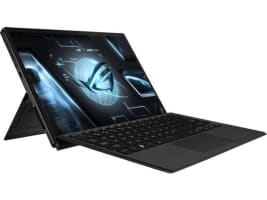
Pros
- Bright 120Hz screen
- USB-C port with Thunderbolt 4
- Unique design
- Good performance for the size
- easily accessible M.2 SSD slot
Cons
- Impractical
- Pricey
- Top-heavy
- lackluster rear camera image quality
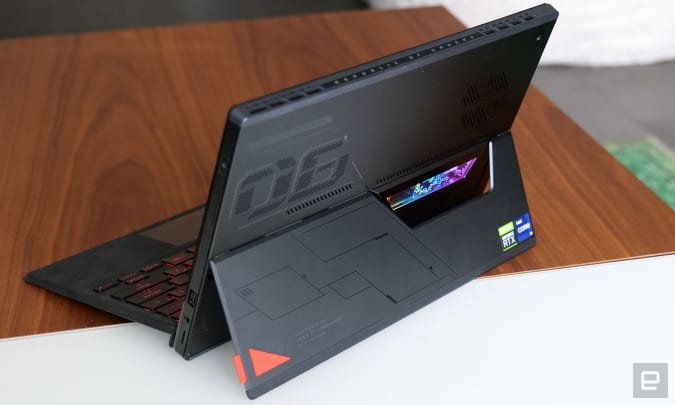
Sam Rutherford/Engadget
That said, while its overall design is a lot like a Surface, the Z13 gives off a very different vibe. ASUS’ over-the-top cyberpunk aesthetic combined with a splash of red and black accents might be a bit much for some. But I kinda love it, especially that window with RGB lighting in back. In fact, I’m gonna go out on a limb and say we need more see-through gadgets in general.
Specs and performance
On the inside, we got some relatively beefy components, particularly for a system this size. We’re talking an Intel Core i9-12900H CPU, 16GB of RAM, a 1TB M.2 SSD, and an RTX 3050TI. In normal use browsing the web or social media, the Z13 is rather quiet, though that changes when you launch a game. Fan noise is noticeable, but doesn’t become a real distraction. And while the back of the Z13 does get warm, ASUS’ tablet design and vapor chamber cooling system helps keep throttling to a minimum.
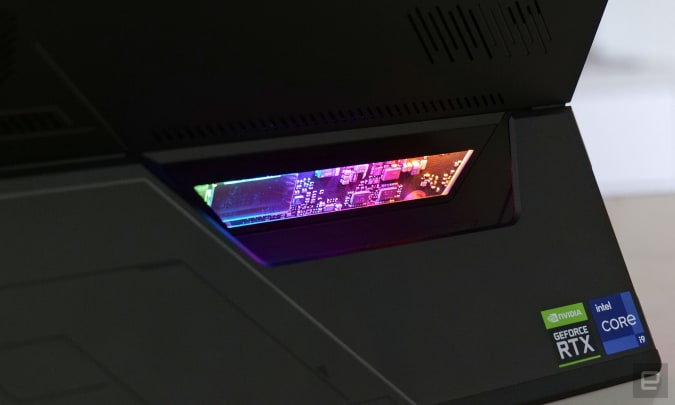
Sam Rutherford/Engadget
Now normally, pairing an i9 chip with a 3050 Ti doesn’t make a lot of sense. In most games, the Z13 is going to be bottlenecked by its GPU, which makes a high-end CPU seem like overkill. In benchmarks, I saw frame rates of 37 fps in Forza Horizon 5 on ultra settings, 64 fps in Shadow of the Tomb Raider on highest and 40 fps in Metro Exodus on high. So decent, but not exactly mind-blowing.
That’s where those hidden ports come in. Once you remove the protective seal, you can attach ASUS’ optional (and expensive) $1,400 XG Mobile graphics dock, which has even more ports (HDMI 2.1, DisplayPort 1.4, Ethernet, four USB 3.2 Type-A ports and an SD card reader), along with an RTX 3080 graphics card. And after I hooked everything up, gaming performance basically doubled, with frame rates in Forza Horizon 5 jumping up to 87 fps at the same settings, with similar results for other titles (134 fps in Shadow of the Tomb Raider and 95 fps in Metro Exodus).
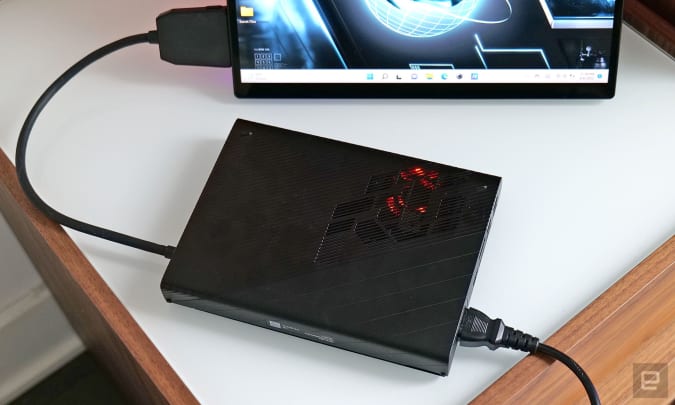
Sam Rutherford/Engadget
So now, we’re looking at a portable gaming tablet that has the kind of performance you’d typically only get from a big 15 or 17-inch notebook. And because the dock is detachable, you have the option to leave it behind if you’re not gonna be gaming. It even has its own power cable, allowing it to send juice to the Z13 when connected. So theoretically, if you throw both of these in your bag, you can leave ASUS’ basic charging brick at home. And when you’re not using the dock, beneath that seal next to ASUS’ proprietary XG port, there’s a USB-C 3.2 connection that supports video out with G-sync.
However, there are a number of quirks about the XG dock. First, you can’t just disconnect it at will. Before you pull the plug, you need to manually disable it from the icon in the Windows system tray, which takes more than a moment. You also can’t pick what GPU goes inside, it’s either an RTX 3080 or nothing. That means if you want to upgrade in the future, you’re gonna have to buy a whole new dock, assuming ASUS even makes a second generation. And because of that proprietary port, the XG Dock is only compatible with this system and the ROG Flow X13, which is basically the laptop version of Z13.
Battery life
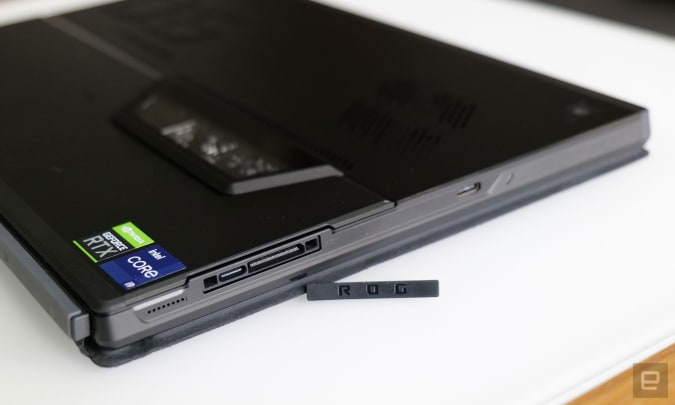
Sam Rutherford/Engadget
One of the biggest downsides of the Z13’s tablet design is not having a lot of room for a sizable battery. In our video rundown test, the system’s 56 Whr power pack lasted just five hours and 38 minutes. That’s four hours shorter than the Zephyrus G14 (9:45) and nearly two and half hours less than the Alienware X14. That means you will probably need to bring ASUS’ power brick whenever you leave the house, especially if you plan on actual gaming. And in the real world, even with the most casual workloads, I found the Z13 was often gasping for energy well before the end of the day. On the plus side, the Z13 uses USB-C Power Delivery, so at least the charger can top up other gadgets too.
Wrap up
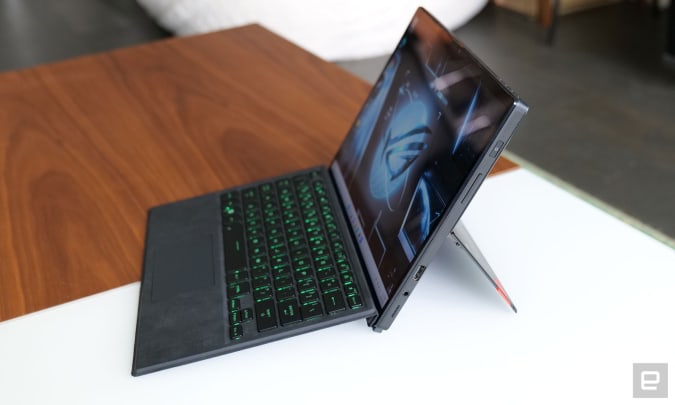
Sam Rutherford/Engadget
When it comes to summing up a product, I’m usually not this conflicted. Don’t get me wrong, I love the idea, I love the way it looks, and I love being able to tack on a beefy GPU when I want extra performance. I also love being able to flip it open, pair a controller and just get to gaming – no need to worry about a keyboard. There really isn’t anything else like the Z13. The problem is that the whole kit isn’t very practical, and it’s not a great value either.
When you’re using it as a laptop – like you know, on your lap – because all of its guts are stuffed inside what is essentially a tablet chassis, it’s really top-heavy. Also, its battery life isn’t very good, lasting at least two to three hours shorter than every other gaming laptop we’ve tested recently. And while it’s relatively thin, when you think about all the accessories you might want to carry around with it, the Z13 doesn’t really let you pack that much lighter when compared to a rival 14 or 15-inch laptop.
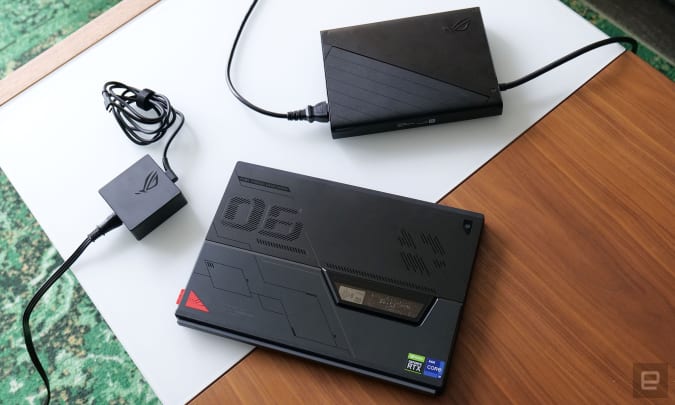
Sam Rutherford/Engadget
And then there’s its price. The Z13 starts at $1,800, or around $1,900 for one similar to our review unit with a 3050TI GPU, which is as high as you can spec it. And if you want the XG mobile graphics dock your all-in price climbs well above $3,000.
A similarly equipped traditional gaming laptop, like an Alienware X14 goes for about $200 less. Meanwhile, ASUS’ own G14 Zephyrus can be had for as little as $1,450, and that’s with a slightly more powerful RTX 3060. So if you just want to be able to game on the go, you can save a bunch of money simply by getting something less exotic. And if you need some extra performance now and then, you’re probably better off getting a regular external GPU enclosure that you can upgrade yourself down the line instead of ASUS’ proprietary dock.
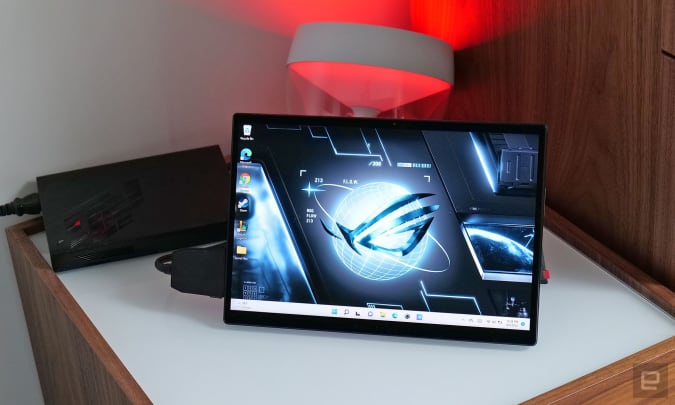
Sam Rutherford/Engadget
Now all this doesn’t mean you shouldn’t get one. But you should know what you’re getting into first. The Flow Z13 is a wildly interesting system, and for people looking for a portable and adaptable machine with big time performance, I’m glad that ASUS finally made a gaming tablet/detachable 2-in-1 into a real device after all these years. And while its high price will make the Z13 an incredibly hard sell for most people, I still think it’s impractically cool.
All products recommended by Engadget are selected by our editorial team, independent of our parent company. Some of our stories include affiliate links. If you buy something through one of these links, we may earn an affiliate commission.
Credit: Source link


Comments are closed.